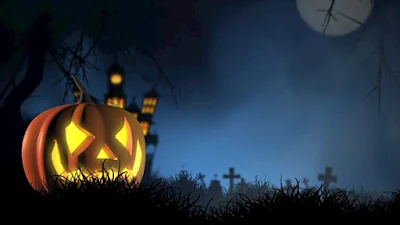 |
Halloween |
Halloween is one of America's most popular holidays however it's not all fancy dress and candy. For the countries who observe this autumnal celebration. Halloween represents a time of superstition and the paranormal as the nights grow darker and winter closes in. Increasingly it seems that this ghostly holiday is also a time for sugar-coated abundance with one-quarter of America's annual confectionary sales occurring around Halloween.
However, it has not always been this way. So where did this peculiar festival originate?
Although the word Halloween is a contraction of the Christian observance of All Hallows Eve hallowed meaning holy. It is widely believed that many of the traditions associated with Halloween can be traced back to ancient festivals. In particular, it is the two-thousand-year-old pre-Christian Celtic festivals of the south.
The night of the thirty first of October. So in marked the start of the Celtic year. It was the end of summer and the harvest season and the beginning of darkness and the cold. Indeed the word sound comes from the old Irish for summers and. Historically it was widely observed throughout Ireland Scotland and the Isle of Man. An important part of the celebrations was the lighting of special bonfires.
As sarin was regarded as a time of year when the boundary between this world and the otherworld was at its thinnest. The bonfires were deemed to have protective and cleansing powers. Due to the proximity of the other world. The counts believed that the souls of dead family members revisited their homes on Selwyn as such lavish hospitality was provided places at feast tables were set for them and offerings of food were left.
Nuts and apples were popular. The prevalence of these foodstuffs can still be seen today in the same traditions of apple bobbing and the roasting of nuts. A mystical race comparable to fairies or Elves are known as the issue was also thought to walk more actively than usual amongst the living on sound.
This meant that guiding namely the tradition of dressing up in costume was practiced because of its effectiveness at disguising oneself from the occasionally fearsome she. It has been suggested that in order to conceal one's identity ashes taken from the sacred bonfire may have been used to blacken participants' faces.
As well as serving protective purpose bonfires were also used to burn offerings of crops and cattle.
Sarin was also an important time of year for the practice of divination.
Halloween is one of America's most popular holidays however it's not all fancy dress and candy.
The presence of otherworldly entities such as the issue was thought to make it easier to predict the future at a time of looming darkness and cold.
A favorable prophecy would provide unrivaled comfort for a superstitious culture.
By the time the Romans left the British Isles in the 5th century A.D. the traditions of sound had evolved. Most notable are the Roman festivals of parent Talia and Pomona. Both would have a lasting impact on the legacy of modern-day Halloween.
The former parents' failure was a nine-day religious holiday held in honor of family ancestors. Although celebrated in mid-February. Parent Alia observed the ties between the living and the dead. In a similar manner to Selwyn. In particular, it is the last day of the festival which historians cite as the most important in the history of Halloween.
The midnight rites which were performed in commemoration of the dead were believed to exercise and cleanse. According to it. Roman citizens were instructed to bring offerings to the tombs of their dead which consisted of at least an arrangement of wreaths a sprinkling of grain and a bit of salt bread soaked in wine and violence scattered about.
The second of the festivals honor the Roman goddess of fruitful abundance Pomona. It is her association with orchard fruit which may help to explain the continued importance of apples. In particular apple bobbing and toffee apples in modern Halloween celebrations.
The widespread observation of Halloween in modern western cultures is largely due to the Christian ization of sarin by the church in the seventh century.
On the 13th of May, six hundred and nine per Bonifaz the fourth dedicated the Pantheon in Rome in honor of all Christian martyrs and thus the Catholic feast of all martyrs Day was established in the western church during the pontificate of Gregory the third.
The festival was expanded to include all saints as well as all martyrs All Saints Day as it was now known was also referred to as All Hallows Day in reference to the holiness of All Saints known and unknown. It was in eight hundred and thirty-five that all Hallows Day was officially moved to the 1st of November at the behest of Pope Gregory the fourth.
As with many other major early Christian festivals including Easter and Christmas, a vigil would be held the night prior to All Hallows day. Thus All Hallows Eve Halloween now fell on the same day as so in between dusk and dawn the thirty-first of October to the 1st of November many historians agree that the church was attempting to replace the widely popular Celtic festival of the dead with a similar charge sanctioned holiday.
By the 9th century. The merger can be said to have been a success as the influence of Christianity spread into Celtic lands blending with and supplanting older Celtic traditions. The following is an extract from a book by a Christian minister which details how the Celtic custom of wearing costumes remained relevant to Christian belief.
It was traditionally believed that the souls of the departed wandered the earth until all saints day and all Hallows Eve provided one last chance for the dead to gain vengeance on their enemies before moving to the next world in order to avoid being recognized by any soul that might be seeking such vengeance. People with don masks will costume to disguise their identities.
The South End tradition of lighting bonfires also lived on in medieval Christendom. Across Medieval Europe, soul lights were lit to guide the souls of the dead as they passed on and to deflect any vengeful amongst them from haunting the households of honest Christian folk.
Similar was the offering of food to departed family members. A practice that continues to this day in Spain is the leaving of special pastries known as bones of the Holy on the grave of loved ones.
Moving closer to modern times. It was not until the influx of Catholic migrants in the 19th century that all Hallows Day and Halloween were celebrated nationally in America. Prior to that rigid Protestant belief systems had limited its observance in areas such as New England. As Halloween spread across the United States a distinctively American version of the holiday began to flourish.
Once more Halloween's Celtic roots were visible this time in the belief amongst young women that they could divine the name or even appearance of their future husbands by doing tricks with mirrors. By the 1920s and 1930s, Halloween was far less religious centric.
Community gatherings and child-friendly activities were prioritized over the remembrance of saints.
Nowadays Halloween is one of the major holidays in America and is celebrated across the western world. Although it looks very different from its sound roots many Celtic traditions including dressing up the association with death superstition and the importance of food and feasting still remain important aspects of modern-day Halloween.
If you enjoyed this. Be sure to like and subscribe and don't forget that you can access more paranormal goodness by visiting paranormal scholar dot com. Our latest article reveals some of the ghostly tales of Stratford upon Avon making it the perfect spine chilling read in time for Halloween.
The more you know the more that is to fear.

Comments
Post a Comment